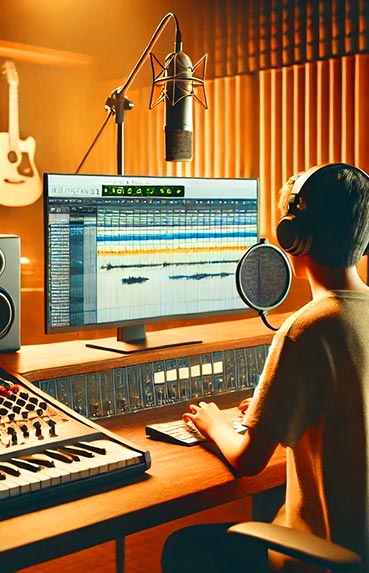Creating a personalized song is a fascinating journey that combines creativity, technique, and emotion. Whether you want to compose for a special event, a unique gift, or simply for the joy of creating, this process can be as rewarding as it is challenging. Below, we'll guide you through each stage of the process, from the conception of the idea to the creation of the final melody.
Discovering the Idea
The creation of a song begins long before writing the first note. It's about finding a central idea that inspires the rest of the composition.
Find Your Inspiration
Inspiration can come from anywhere: a personal experience, an emotion, an event, or even a phrase heard by chance. Here are some ways to discover that creative spark:
- Personal Experiences: Reflect on significant moments in your life. Is there an event you want to commemorate?
- Stories of Others: Sometimes, other people's stories can be a rich source of inspiration. Talk to friends or family and listen to their tales.
- Art and Culture: Listen to music, read books, or watch movies that move you. Culture is a vast ocean of inspiration.
Define the Theme
Once you find your inspiration, it's crucial to define the main theme of your song. Is it a love song, a reflection on life, or an epic story? Defining the theme will help you stay focused throughout the creation process.
Structuring the Song
With the idea clear, the next step is to give structure to your song. The structure will help you organize your thoughts and ensure the song flows coherently.
Common Structures
There are several common structures in songs that can serve as a guide:
- Verse - Chorus - Verse - Chorus - Bridge - Chorus: This is one of the most popular structures in pop music.
- Verse - Chorus - Verse - Chorus: Used in simpler, more direct songs.
- AABA: A classic structure where section B offers a contrast before returning to section A.
The Role of Each Section
- Verse: This is where the story or message develops. It's the place to detail and delve deeper.
- Chorus: The most memorable part of the song, with a catchy melody and lyrics that summarize the theme.
- Bridge: Offers a variation and often introduces a new perspective or emotion.
Writing the Lyrics
Now that you have a structure, it's time to put words to your ideas. The lyrics are an essential part of the song, as they convey the message to the listener.
Tips for Writing Effective Lyrics
- Simplicity: Often, less is more. Avoid overcomplicating the language.
- Rhymes and Rhythm: Use rhymes to give musicality to the lyrics and pay attention to the rhythm of the words.
- Emotion: Emotional authenticity is key. Lyrics that touch the listener's heart tend to be the most memorable.
Practical Example
Imagine you're writing a song about personal growth. A verse could describe the challenges faced, while the chorus celebrates triumph and resilience.
"Writing a song is like painting a picture: each word and note contribute to the final masterpiece."
Creating the Melody
The melody is the soul of the song. It's what makes people hum and remember your work.
Find the Right Melody
- Experiment: Take the time to experiment with different notes and chord progressions. Sometimes, a simple variation can make all the difference.
- Digital Tools: Use music creation software to try out ideas and record melodic sketches.
Tips for a Catchy Melody
- Repetition: Melodies that repeat are often easier to remember.
- Contrast: Introduce melodic variations to maintain interest.
- Fit the Lyrics: Ensure that the melody complements and enhances the lyrics.
Production and Arrangements
Once you have the lyrics and melody, it's time to bring the song to life with production and arrangements.
Selecting Instruments
Choose instruments that align with the tone and theme of your song. For example:
- Acoustic Guitar: Ideal for intimate ballads.
- Synthesizers: Perfect for pop or electronic songs.
- Orchestra: Adds an epic feel to the music.
Musical Arrangements
- Dynamics: Introduce changes in dynamics to add interest. Play with volume and intensity.
- Sound Layers: Adding different layers of sound can enrich the listening experience.
Recording and Editing
Recording is where your song takes physical shape. It's important to pay attention to every detail to achieve a quality final product.
Recording Process
- Professional Studio vs. Home: Decide whether you'll record in a professional studio or at home. Both options have advantages and disadvantages.
- Multiple Takes: Record multiple takes to have options when editing.
Editing and Mixing
- Error Correction: Use editing software to correct minor errors in the recording.
- Mixing: Adjust the balance between the different elements of the song to achieve a cohesive mix.
Sharing Your Song
Once completed, the final step is to share your work with the world. This is where all the hard work finds its reward.
Distribution Platforms
- Social Media: Platforms like Instagram, YouTube, or TikTok are great for sharing your music.
- Streaming Services: Consider uploading your song to Spotify, Apple Music, or other streaming platforms.
Connecting with the Audience
- Interaction: Encourage interaction with your audience. Listen to their feedback and respond to their questions.
- Live Events: If possible, perform your song at live events to create a deeper connection with the audience.
Creating a personalized song is a process that requires time, patience, and dedication. However, with the right guidance and a genuine passion for music, anyone can take an idea from their mind to a melody that resonates in the hearts of many.

















